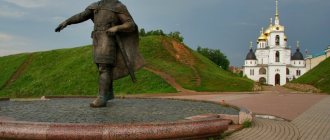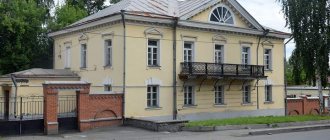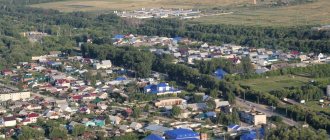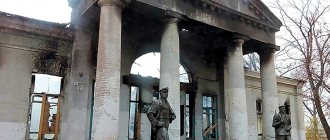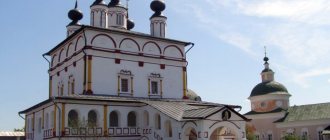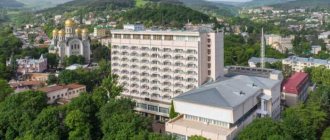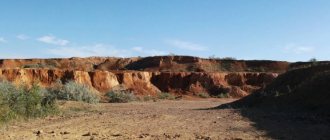Sights of Korolev - what can you see in the city?
Korolev is a large city in the Moscow region, located 7 kilometers from the Moscow Ring Road. The city, founded in 1936, has a population of more than 200 thousand people.
The city grew from a workers' village, receiving city status in 1938. Until 1996, the city was called Kaliningrad, after which it was renamed Korolev.
There are many cultural and historical attractions in Korolev, a detailed description of which will be found below.
What to see in the city of Korolev in 1 day
The vast majority of people associate Korolev with science and space. Tourists come to the science city to get acquainted with the achievements of Soviet and Russian scientists. The city is also visited by fans of Marina Tsvetaeva, because it is here that one of the main museums in memory of the great poetess is located.
Mission Control Center
- Address: Pionerskaya st., 4, bldg. 1.
Korolev is the citadel of the Russian space industry. The famous MCC has been monitoring the movements and actions of spacecraft since the 60s. These days, the center hosts excursions where visitors can see with their own eyes the work of specialists and watch a live video broadcast from space. When visiting the MCC, you must turn off your mobile phones.
RSC Energia Museum
- Address: st. Lenina, 4A.
The modern Rocket and Space Corporation (RSC) is a direct descendant of the famous design bureau founded by Sergei Korolev. The corporation operates a museum dedicated to the history of space exploration. It contains the very first samples of spacesuits, artificial satellites, ballistic missiles and the real Vostok-2 spacecraft. In a separate room, experts reproduced the furnishings of Korolev’s office.
House-Museum of M.I. Tsvetaeva
- Address: st. Marina Tsvetaeva, 15.
Modern Korolev consists of several settlements, one of the oldest and most significant among them is the village of Bolshevo. Here, under the tall pines, a green wooden house with large windows was lost. The small mansion is the place where the famous poetess Marina Tsvetaeva lived in 1939 after returning from France.
Marina Ivanovna spent less than six months in the village, but the events that occurred during this period of time had a terrible impact on the future life of the long-suffering woman. After 17 years of emigration and life in poverty, Tsvetaeva was forced to return to her homeland, which greeted the poetess harshly and only prepared new challenges for her. After the arrest of her husband and daughter, Marina Ivanovna was left alone with her youngest son and had difficulty surviving without the help of family and friends.
The Tsvetaeva Museum began operating in 1992. The house contains objects that are related to the life and work of the famous poetess. The rooms have preserved original furniture and dishes that belonged to Marina Ivanovna. Near the entrance to the house, guests are greeted by a stone sculpture of Tsvetaeva.
Where to go for a walk in Korolev with children and adults
In addition to the “cosmic” attractions, tourists should visit the wonderful natural spots and cultural sites of the city.
"Elk Island"
- Coordinates on the map: 55.858333, 37.814444.
The urban district of Korolev borders on one of the first national parks in Russia. The reserve received its unusual name due to the large population of moose living in the local forests. In addition to the horned beauties, the park is home to foxes, muskrats, beavers, and various species of birds. Museums are open on the territory of the reserve, exciting excursions and horseback riding are held.
Park named after Marina Tsvetaeva
- Address: corner of Uritsky and Marina Tsvetaeva streets.
House-Museum of M.I. Tsvetaeva is located in a picturesque corner of the Bolshevo microdistrict. In 1939, the poetess collected brushwood here to light the stove, heat the house and cook food. Since then the place has changed. A semi-wild plot of land has turned into a well-equipped Literary Park with neat paths, benches for relaxation and bright flower beds. Large stone boulders with bronze tablets with poems by Marina Tsvetaeva are placed everywhere.
Square of Space Conquerors
- Address: corner of Oktyabrskaya and Kalinina streets.
The square near the Drama Theater is a great place for walking and relaxing. The area was landscaped in 2002, the paths are tiled, and bright flowers grow everywhere. Playgrounds have been built for children. In the center of the square stands one of the best sculptural compositions of the city - a monument to S. Korolev and Yu. Gagarin.
Central Palace of Culture
- Address: st. Tereshkova, 1.
Construction of the Palace of Culture began in 1958 on the initiative of Sergei Korolev. The scientist personally laid the first stone in the foundation of the future structure. The work lasted 6 years and in 1964 the Palace opened its doors to residents of the science city. Important cultural events, folk festivals, holiday concerts and even sporting competitions take place in the building itself and in the square next to it.
General information and history of Korolev
The date of foundation of the city is December 26, 1938. It is located at a distance of 6–7 km from the Moscow Ring Road when driving along the Yaroslavl Highway, 23 km from the center of Moscow. Since 2014, it has included the former city of Yubileiny.
The city is surrounded by forests, tracts and the Losiny Ostrov national park. The river flows through the territory. Klyazma, which in ancient times was part of the water trade route from Moscow to Vladimir and Suzdal. The development of the village was accelerated by the passage of a railway near it and the construction of a factory for the production of guns.
City status was awarded in 1938. In honor of space technology designer S.P. Korolev, the city was renamed on July 8, 1996. The complex of scientific and production enterprises and institutions that emerged after the war during the development of the rocket and space industry of the USSR is the main management center of Russia in this direction.
Royal museums and theaters
Korolev is not only a citadel of science, but also a cultural center. The city has museums and theaters for people of all ages.
Royal History Museum
- Address: st. Tereshkova, 1.
The main Korolev Museum was formed in 2005 and united several old museums: space, history and local history. The opening was timed to coincide with the 60th anniversary of the Great Victory. The exhibitions cover the history of the space and defense industry in Korolev, and also demonstrate the life of the inhabitants of the Russian Empire and the Soviet Union. The museum features the largest collection of military and civilian vehicles.
Kostino Estate Museum
- Address: st. Ilyich, 1A.
At different times, interesting historical figures lived in the estate in the village of Kostino: the Dolgoruky princes and the revolutionary Vladimir Lenin. The modern building was built at the beginning of the 20th century; in 1922, the “Father of the Revolution” lived in it. At that time, Vladimir Ilyich was already seriously ill and soon moved to Moscow, where he died two years later.
In 1924, troubled teenagers, orphans and street children began to be brought to Kostino. The estate became a kind of labor correctional colony for juvenile delinquents. In 1939, the estate was transformed into a museum in memory of Lenin. Over time, the profile of the museum expanded to include local history and art exhibitions.
House-Museum of S.N. Durylina
- Address: Svobodnaya st., 12, Bolshevo microdistrict.
Sergei Nikolaevich Durylin is one of the most famous residents of Korolev, a writer and scientist who studied issues of philosophy and theology. In 1936, the writer settled with his wife in a small log house with an unusual semicircular projection.
Famous artists and writers often came to see the theologian, including the famous painter M. Nesterov. Here Sergei Nikolaevich ended his earthly journey.
In 1993, the house was transformed into a museum in memory of the poet; many personal belongings of the writer were preserved inside, such as furniture, books, photographs, as well as a rich collection of paintings by Soviet and Russian artists and ancient icons.
House-Museum of O.M. Kuvaeva
- Address: Bolshevskoye sh., 31.
Oleg Mikhailovich Kuvaev is an outstanding Soviet geologist, writer, screenwriter, who became famous thanks to his stories and essays about geological expeditions. The author’s most important work is the novel “Territory,” which has been reprinted dozens of times, translated into many languages and filmed twice in 1978 and 2014.
In the 60s, Kuvaev decided to leave geology and devote himself entirely to writing prose. In 1966, Oleg Mikhailovich settled in Kaliningrad near Moscow and lived there until his death in 1975. The writer’s sister and nephew founded a museum in the house in memory of the famous relative. The house contains the geologist’s personal belongings and various editions of his works.
Drama Theater
- Address: st. Tereshkova, 1.
Many residents of Korolev are not only intellectually, but also creatively gifted people who value theatrical art. The first performances in Podlipki began to take place back in 1924. Despite repeated changes in the names of the village and city, the theater remained the “Comedy and Drama Theater in Podlipki” until 2005.
For many years the repertoire consisted mainly of folk works. In 2005, the post of artistic director was taken by Andrei Kryuchkov, who radically changed both the direction of the theater and its cast.
Theater for Young Spectators
- Address: Kaliningradskaya st., 12.
Residents of Korolev care about cultural leisure not only for adults, but also for children. In 1994, the Theater for Young Spectators opened in the city. The first amateur performances took place back in 1976 at the children's club of the local House of Culture.
In 1983, the amateur theater received the status of “folk”, and 11 years later it became professional. In 2002, the Youth Theater moved to a separate building. Little queens not only watch fairy-tale performances, but also learn acting skills and participate in productions.
Read in the topic: The best attractions of the Moscow region
Architectural monuments Queen
Korolev is a young city, but several architectural monuments of the 19th century have been preserved on its territory, as well as interesting examples of Soviet architectural thought.
Lapino-Spasskoye Estate
- Address: microdistrict Pervomaisky, st. Sovetskaya, 9.
The estate in the village of Lapino appeared in the 19th century thanks to the local manufacturer Panteleev. In subsequent years, the estate changed several owners, and the last owner of the mansion and adjacent buildings was entrepreneur A.N. Craft. After the change of government, the estate turned into socialist property and served the working people.
Several buildings have survived to this day, among which the three-story manor house and a small one-story outbuilding stand out. The main house housed a kindergarten; a music school still operates in the outbuilding. The mansion requires major renovations; the building is currently abandoned.
Culture and Leisure Center
- Address: Sovetskaya st., 71, Pervomaisky microdistrict.
The building of the cultural center in Bolshevo is an architectural monument of the 19th century. Initially, the simple brick building belonged to a dyeing factory and only in Soviet times became the main cultural attraction of the village.
For a long time, the youth club “Fakel” worked here; club members organized the first drama club in the settlement. Today the center accommodates more than a dozen creative groups, children's clubs and interest clubs.
First house of MZhK
- Address: ave. Koroleva, 18/6.
The youth residential complex is a unique example of Soviet architecture. From 1971 to 1991, massive construction projects took place throughout the Union, and houses were erected for young families. At the beginning of the all-Union experiment, young builders from all over the country came to Kaliningrad, the future Korolev.
It was here that the very first multi-storey building of the complex was built. The façade of the building, like a beehive, consists entirely of cell-balconies. Some of the apartments are still occupied by the families of the original residents.
Which Queen Temples are worth visiting?
Many residents of the science city are believers; therefore, in the territory of the urban district you can find many active Orthodox churches.
Church of the Life-Giving Trinity
- Address: st. Gorky, 77.
The delightful Trinity Cathedral is the largest church in the city. The construction of the red brick building began in 2006; three years before that, the wooden Church of the Life-Giving Trinity was built. In 2007, the construction of a two-story, five-domed cathedral and a multi-tiered bell tower was completed. The central entrance was decorated with a huge image of the Old Testament Trinity.
The lower church of the cathedral has two chapels, the main chapel is consecrated in honor of the Pochaev Icon of the Mother of God, the small chapel is in honor of the Nativity of John the Baptist and St. Spyridon of Trimythous. The church hosts classes for Sunday school students, and also operates a library of church literature.
Church of Saints Cosmas and Damian
- Address: Stationnaya str., 43, Bolshevo microdistrict.
The Church of the Unmercenary Saints Cosmas and Damian is one of the oldest in the village of Bolshevo and in the whole of Korolev. The first mention of the temple dates back to the 16th century, but the original building did not survive. The modern stone structure was built at the end of the 18th century with donations from Prince Pyotr Ivanovich Odoevsky, a famous writer and philanthropist.
The building changed its external and internal appearance more than once; the most serious changes occurred during the Soviet period, when the temple was captured by the Bolsheviks and partially destroyed. Near the church walls there are several graves in which past abbots and clergy of the temple are buried.
Church of the Transfiguration
- Address: Stationnaya str., 45A, Bolshevo microdistrict.
A few meters from the temple of Cosmas and Damian there is another interesting parish. From the outside, the bright yellow church looks like an ordinary multi-story building or city institution. Only the semicircular apse on the eastern side and the gilded domes with crosses indicate that the building belongs to religion. The three floors of the structure housed the Church of the Transfiguration of the Lord, a Sunday school, a library and utility rooms.
The unusual church was erected at the beginning of the 19th century at the expense of Prince P.I. Odoevsky. During Soviet times, the Bolshevo administration worked in the building. After the collapse of the USSR, the building was returned to the Church and re-consecrated. Currently, services are held in the temple and lessons of the Law of God are held. Restoration work continues to this day.
Church of the Nativity of the Blessed Virgin Mary
- Address: Kaliningradskaya st., 1.
The bright Nativity Church is one of the main decorations of the village of Kostino. The blue and white brick building was erected in 1999 on the site of a wooden church from the 17th century. The ancient structure was destroyed by the Bolsheviks at the beginning of the 20th century, at which time the Smolensk Icon of the Mother of God, which had been kept in the church for many years and was revered as miraculous, disappeared without a trace. The church is open to pilgrims and tourists.
Chapel of St. Alexander Nevsky
- Address: st. Tsiolkovsky, 26.
A tall chapel of an unusual shape is located near the Walk of Fame and is part of the memorial complex. The beautiful building looks more like a bell tower; in the upper tier there is a belfry. The black roof sets off the white walls with beautiful bas-reliefs.
The chapel was built in 1999 and consecrated in honor of the blessed Prince Alexander Nevsky, the patron saint of the army. During services in the church, all those who fell during the Great Patriotic War are remembered.
For children
In addition to museums, Korolev has many cultural attractions whose events will be interesting for children:
- · Drama Theater;
- · Theater of Young Spectators;
- · Central House of Culture named after Kalinin.
In Korolev there is the ancient Church of Cosmas and Damian, dating back to the 18th century. The church was built in 1786, on the site of the destroyed temple of the same name. In the 20s of the last century, the church was looted. However, local residents managed to restore the shrine, which continued services during the Soviet period. Today, ancient icons of the holy wonderworkers Cosmas and Damian are kept here, and hundreds of Orthodox parishioners come to venerate them.
Korolev is a city with its own unique history; famous creative personalities, scientists and political figures lived and stayed here. Many tourists from the capital come here to take a break from the bustle of the city and touch the history of the 19-12 centuries and take memorable photos.
Main monuments in Korolev
The kings do not skimp on monuments for important historical figures and prominent citizens.
To the creators of space technology
- Address: Yaroslavskoe highway.
At the entrance to the city there is its main symbol - the R-2 ballistic missile, which was invented by Sergei Korolev in 1948. A stone copy of the rocket on the launcher was built in 1997 - for the 40th anniversary of the launch of the first artificial satellite. An unusual sign indicates to drivers that they are entering a defense and space industry city.
Monument to S.P. Queen
- Address: ave. Queen.
A city with a human surname could not do without a monument to the one in whose honor it was named. A huge bronze figure of the academician on a granite pedestal rises on the central city avenue, which also bears the name of the great Soviet scientist.
Korolev is depicted in motion, which perfectly characterizes the designer: Sergei Petrovich constantly worked, never stopped on his laurels and always moved forward in the literal and figurative sense of the word.
The monument was erected in 1988, 22 years after the early death of the scientist. Korolev’s students and colleagues, people who knew him personally, came from all over the country to attend the grand opening. Today, couples in love meet and families walk near the monument.
Monument "Korolev and Gagarin"
- Address: Space Conquerors Square.
In the “Conquerors of Space” park there is another monument to Academician Korolev. The great designer sits on a bench with the world's first cosmonaut Yu.A. Gagarin. The space pioneers are talking about something, perhaps discussing the first flight. The sculptural composition stands in the center of a round stone pedestal, on which local residents place flowers every year.
Memorial of Military Glory
- Address: Victory Square.
The Queen Memorial Complex consists of several monuments. The main monument is three stone figures on a high pedestal. A woman is depicted in the center of the composition, with male soldiers on either side of her. The female figure simultaneously symbolizes the home front workers, who shouldered heavy male labor, and the peaceful life for which the soldiers fought.
At the foot of the monument are carved the names of local residents who died on the battlefields. A little to the side stands a massive granite star with the names of Kaliningrad residents awarded the title of Hero of the Soviet Union. In 2000, the memorial complex was replenished with a monument to those killed in local wars.
Parks, squares
The administration of the city of Korolev pays great attention to the development of park areas and public gardens within the boundaries of the settlement, which have enjoyed constant popularity among citizens for many years.
Losiny Ostrov National Park
The large national park “Losiny Ostrov” (an area of about 12 thousand hectares) is located between Moscow and several cities near Moscow (Mytishchi, Korolev, Balashikha and Shchelkovo), forming a forest wedged between the 2nd highway (Yaroslavsky and Shchelkovsky).
The park is home to mammals (48 species), birds (more than 200 species) and reptiles; many different plants grow (about 1 thousand species); There are beautiful natural lakes.
The ecological centers of the park are:
- “Russian Life” and “Abramtsevo” (Losiny Ostrov massif);
- “Tea drinking in Mytishchi” (forest park of the same name);
- "Red Pine" (children's education center);
- “Ancient Russian Hunting” (museum complex);
- environmental center for children;
- arboretum.
These centers carry out educational and historical work, telling visitors about the history of the reserve, national traditions and Russian hunting, the animal world of forests and lakes; They conduct themed games and horseback riding excursions. You can visit the park freely.
Square "Conquerors of Space"
Spread in front of the central city palace of culture. The square was opened in 2012 to commemorate the 55th anniversary of the flight of the first artificial Earth satellite. Local residents equipped and landscaped the area.
More than 100 trees of various species were planted here, walking paths were laid and many benches were installed.
Marina Tsvetaeva Park
On the street In 2013, M. Tsvetaeva opened a modest-sized park dedicated to the famous poetess to the public. On the territory you can find many stones on which tablets with poems are attached. A summer amphitheater is equipped for street performances. Parents with children love to visit the interesting playground. Every year on June 19, a large bonfire is held in the park in honor of the poetess.
Central City Park named after. M.I. Kalinina
The formation of the city's park area dates back to the late 30s of the last century. At that time, alleys and recreation areas were not developed on the territory of the green urban area. The townspeople used naturally formed paths and clearings. During the war years, the park's trees were cut down for heating purposes. Since 1948, a new history of the city's recreation area begins.
The restoration is proceeding according to plan with the formation of:
- alleys;
- pedestrian paths;
- park infrastructure objects (pavilions, stages, platforms, sculptures);
- decorative decorations (lanterns and flower beds);
- places for benches.
Local residents enthusiastically took part in the development of the park area. After opening in 1950, the park quickly became a favorite place for recreation and entertainment for city residents. Gradually, various attractions were installed on the territory, concerts and films, music and dance evenings were organized, and a ski track was laid in the winter.
For a long time (until 1994), the park infrastructure was sponsored by local industrial enterprises. Then, until 2016, the park was on the balance sheet of the municipality and gradually fell into disrepair due to the lack of normal funding. Currently, active work is being carried out to restore and improve the city’s central park.
Kostino Park
Located at: st. Dzerzhinsky, 26. The history of the park begins in 1962, when, on the initiative of youth organizations of the city, an apple orchard was founded near the built Palace of Culture.
Currently, the park area is being improved:
- young fruit trees were planted;
- beautiful decorative objects were installed;
- a bright gazebo-gallery was built;
- There are benches for relaxation at the children's playground.

